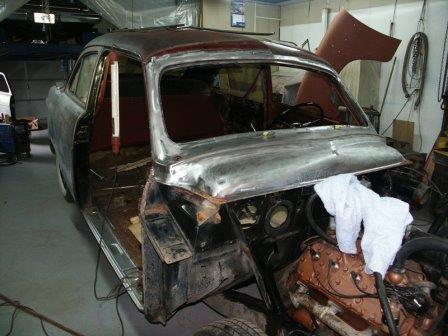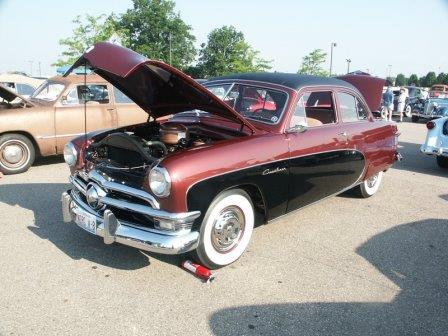Nettie Comes Home – Part II
By Ken Bounds
 Over
the next several months Everett put over 850 hours into correcting most of
Nettie’s problems. He stripped all
the old paint, replaced sheet metal in the floor, trunk, and rocker panels, did
body work to properly repair accidents from long ago, replaced the hood and
trunk, realigned the doors, and applied a beautiful basecoat/clearcoat finish in
a nearly perfect match to the original color. This one-sentence summary doesn’t
adequately explain the amount of work that Everett did and the quality and care
he put into it.
Over
the next several months Everett put over 850 hours into correcting most of
Nettie’s problems. He stripped all
the old paint, replaced sheet metal in the floor, trunk, and rocker panels, did
body work to properly repair accidents from long ago, replaced the hood and
trunk, realigned the doors, and applied a beautiful basecoat/clearcoat finish in
a nearly perfect match to the original color. This one-sentence summary doesn’t
adequately explain the amount of work that Everett did and the quality and care
he put into it.
Everett did one other thing that
was very significant. He found a
fabric shop, SMS in Canby, OR, that was able to create an almost exact
reproduction of the interior fabric.
I had been looking for such a match for many years and had basically concluded
that it was just not available.
Everett then recommended that we have Dave Schober of Schober’s Custom Hot Rod
Interiors in Yorkville replace the interior and vinyl top.
That was a great recommendation because Dave’s work was outstanding.
Health concerns on Everett’s end
and family priorities on mine prolonged the restoration process to nearly a
year. But when I went to look over
the reassembled car in late January 2008, we had a new problem.
The quality of the restoration work by Everett and Dave were just too
good. Now the grill, bumpers,
chassis, and engine compartment simply weren’t good enough compared to the rest
of the car. Somewhere, sometime
along the way, Old Nettie became deserving of being more than just a presentable
“driver”. A crazy thought entered my
head. How much more work would it
take to improve Nettie to the next level:
entering her in the Concourse class at the Grand National Meet in
Dearborn, only five months away? I
decided to go for it and began assembling parts and planning for the final
stages of the restoration while waiting for nicer weather.
Finally, on March 11, 2008, it was time for Nettie to once again come
home.
 The
major components of the restoration were complete.
The body and the interior looked terrific; all the specialized Crestliner
parts were present. Using a variety
of resources I started researching what details were needed to put a finishing
touch on the restoration. The
1949-50-51 Ford Restoration book published by the Early Ford V-8 Club was
invaluable, as were the many e-mails patiently answered by the book’s author,
Cecil Goff. I also researched every
Crestliner article I could find in the V-8 times and pored over pictures I had
taken of Crestliners over the years.
Another great resource is the club’s judging manual which gives an abundance of
information about what the judges are looking for.
The
major components of the restoration were complete.
The body and the interior looked terrific; all the specialized Crestliner
parts were present. Using a variety
of resources I started researching what details were needed to put a finishing
touch on the restoration. The
1949-50-51 Ford Restoration book published by the Early Ford V-8 Club was
invaluable, as were the many e-mails patiently answered by the book’s author,
Cecil Goff. I also researched every
Crestliner article I could find in the V-8 times and pored over pictures I had
taken of Crestliners over the years.
Another great resource is the club’s judging manual which gives an abundance of
information about what the judges are looking for.
I knew that there would likely
not be enough time to have the bumpers and grill re-chromed, but I got lucky and
found a complete NOS grill and re-chromed bumpers on e-Bay, probably for less
than the cost of re-chroming locally.
Perhaps one of the best investments was a plating kit called copy-cad
from Caswell in New Jersey. Most of
the fasteners on the 1950 Ford were either cadmium-plated or zinc-plated and
reproductions of many of them are just not available.
There are so-called Cad paints available, but they just don’t look right.
Over the next few months I spent dozens of hours removing hundreds of
fasteners, cleaning them up, plating them, and reinstalling them.
The plating looks terrific. I
guess you just don’t realize how many nuts and bolts hold your car together!
I bit the bullet and replaced my smooth-riding radials with bias tires.
Although I prefer the radials, they still result in a point deduction on
the concourse and they don’t work well with the Crestliner’s full wheel covers.
One of the most daunting tasks
was cleaning up and painting the suspension and the undercarriage.
Poor Nettie was still carrying the mud, road tar, and surface rust from
her earlier life. Oh, why didn’t I
do a body off restoration? Too late
for that now – all you can do is get under there and get to work.
After weeks of scraping, cleaning, scraping, sanding, and refinishing I
was beginning to see progress. The
entire front suspension and the undercarriage to the back of the front wheels
was complete, but there was still a long way to go.
It was about this time that I had a revelation:
I was no longer doing this work for the judges, but instead was doing it
to make the car better. Nettie had
survived for 58 years and with proper care and preservation could last many
more.
The work continued.
New shock absorbers; new tailpipe brackets; more bolts to refinish; new
spark plug wires; lots of detailing and refinishing under the hood; and hours of
straightening hundreds of fins in the radiator.
The details seemed endless.
Suddenly it was early July and
the meet was less than two weeks away.
I realized that there was just enough time to get the car put back
together and prepared for the meet.
I would not be able to complete restoration of the undercarriage.
I seriously considered not taking Nettie to Dearborn and waiting to show
it at a future date. But, I decided
that the best thing was to show the car and get advice from the judges about
what needed improvement. That turned
out to be a good decision! I spent
the next week getting everything reassembled on the car, only to learn that
there was a problem with the wiring.
I couldn’t get the turn signals and the parking lights to work correctly.
Fortunately, I just happened to have a complete wiring harness and
decided to bite the bullet and replace most of the wiring.
I feared that the main dash/engine harness might take a couple of days,
but it only took me half a day.
Finally, everything was coming together and I was able to take Nettie for a test
drive only five days before we were to leave for Dearborn.
About the only major item remaining was to attach the rear bumper.
That went OK until the holes didn’t line up!
Oh, oh. I now realized that I
had purchased a late 1949 bumper, not a ’50.
A quick swap from the convertible and problem solved.
A few days of lubrication, cleaning, polishing, and fine detailing and at
last, Nettie was ready to go.
On July 13, Nettie proudly led a
group of nine V-8’s from the Northern Illinois Regional Group to Dearborn.
We were pleased that there was no rain, so undercarriage cleanup at the
meet would be minimal. Arriving at a
V-8 National Meet is always a great time, renewing friendships with fellow
flathead enthusiasts from all over the country.
I was especially excited to drive Nettie over to old friend John
Treadway’s swap space since he had been the source of many of the super-nice
Crestliner parts on this car. The
quality of John’s work cannot be beaten and it was a treat to show him how they
looked on the finished car.
 The
2008 Grand National was my 17th national meet.
But in all those previous meets I had always entered my “drivers” in
Touring Class. You really can’t
appreciate the anticipation of concourse day until the first time you have a car
point judged. In the days leading up
to concourse, there is continued fretting about all the last-minute details to
make sure everything is perfect.
Cleaning the undercarriage; detailing the paint and under the hood; scrub those
whitewalls; clean out the trunk – all the last-minute details to be ready on
“judgment day”.
The
2008 Grand National was my 17th national meet.
But in all those previous meets I had always entered my “drivers” in
Touring Class. You really can’t
appreciate the anticipation of concourse day until the first time you have a car
point judged. In the days leading up
to concourse, there is continued fretting about all the last-minute details to
make sure everything is perfect.
Cleaning the undercarriage; detailing the paint and under the hood; scrub those
whitewalls; clean out the trunk – all the last-minute details to be ready on
“judgment day”.
You just can’t help being nervous
when the judging team descends on your “baby”.
For years I have heard about how the V-8 Club judges will pick your car
apart. I’ve watched the John
McBurney judging video about being a professional, “Don’t kill the car”, etc.,
but still had the fears. I sat back
in my chair and watched the judges swarm over the car: the interior, the
exterior, the chassis, the engine compartment.
Guess what? They were not
picky at all, but totally professional.
When the Deputy Judge, Jerry Reichel, came over to give me “the bad
news”, my mind was racing. Nettie
needed 950 points to get a Dearborn award.
Would I remember everything Jerry told me?
Could I do the math fast enough to keep up with the point deductions?
I listened to Jerry and started adding up the points deducted.
My brain was buzzing, but
unexpectedly, Jerry said “That’s it.”
I thought he was kidding. But
he was serious. Just this quickly,
it was over. The time, the effort,
the hard work, the worry had all paid off.
Nettie was going to be recognized with a Dearborn!
My mind flashed back to Nettie (the person) careening around her ranch in
the old Ford nearly 60 years ago. My
excitement about buying the car 20 years ago.
The pride I felt when my dad drove the car to the first meet so long ago.
I truly wished he could still be here to see this day.
As I went up to the stage at the awards banquet to receive the Dearborn
plaque from President Craig Gorris and National Chief Judge Jerry Vincentini, I
was proud that I had been part of an effort to preserve this small piece of
Americana. I am truly thankful to
all the talented folks who contributed to returning Nettie closer to the way she
rolled off the Chicago assembly line so many years ago.
On July 19, Nettie once again came home.